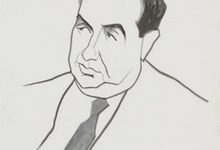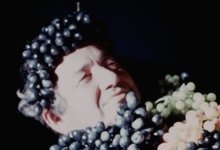- Images (4)
- Liens (0)
- Agenda (0)

|

|

|

|

|

|

|

|
American.
Walter Gutman made his first film in 1969 at the age of sixty-six. His critical interest in the arts dates back to the mid-1920s as a contributing art critic at the Nation, New Republic, Creative Arts, and Art in America, and his commitment to experimental independent film has been felt for decades. His own creative filmmaking debut commenced with a wacky, ribald feature The Grape Dealer’s Daughter, an autobiographical meditation on sexual desire that involves the search for the perfect combination of nubile young women and juicy grapes. In total, he produced 10 features and 19 short films and completed his last film The Woman When Sacred in 1986 a month before he died in New York City.
Proclaimed by the New Yorker magazine as “A Proust in Wall Street,” his success in the stock market allowed him to return to the art world where during the 1950s he studied sketching with the sculptor Ben Karp and the abstract expressionist Jack Tworkov. His works in watercolor and oil painting and still photography have become the subject of several one-person shows. His personal collection of fine art made by a who’s who of mid-to-late 20th century American artists and of his own works now resides at the Solomon R. Guggenheim Museum, Wadsworth Atheneum, Whitney Museum of American Art, International Center for Photography, Museum of Modern Art, Anthology Film Archives, and Bowdoin College Museum of Art.
Gutman became involved with the New American Cinema in 1959 producing Alfred Leslie and Robert Frank’s Pull My Daisy and The Sins of Jesus (1961), by banking upon friendships with the poverty-stricken Beat novelist and poet Jack Kerouac and the successful mutual fund money manager Jack Dreyfus. Gutman financed many legacy art films, such as George Kuchar’s Unstrap Me (1968), based upon a Gutman short story and starring Gutman as “Bojo,” a lecherous older man seeking a younger female soul mate, and The House of the White People (1968), an excerpt from Unstrap Me featuring the plaster-casting of the famed underground movie actress Donna Kerness by American sculptor George Segal.
In 1966, Walter was one of the prime backers behind the innovative event 9 Evenings: Theatre and Engineering, a series of collaborative performances between avant-garde artists and engineers that resulted in the formation of the Bell Lab’s sponsored group Experiments in Art and Technology (E.A.T.).
His support of provocative new feminists included critic and activists Jill Johnston, dance choreographer Trisha Brown, painter-sculptor-performance artist Carole Schnemann, ciné dance innovator Amy Greenfield, and numerous other up and coming artists, writers, musicians, poets, and filmmakers with grants awarded through his Benedict Arnold Foundation.
Gutman’s depictions of women -- a continuing and obsessive theme -- are always affectionate, emphasizing strength and grace in movement. Often he has filmed dancers and acrobats, finding in them models of what he feels is most vital and compelling in all life. —Robert A. Haller / Bruce Posner
“My great interest in life is strong women. That’s why I began to make movies. Not because I wanted to break down any doors in Hollywood.” —Walter Gutman, quoted in Newsday 1970
“No King Lear, Gutman was genuinely interested in the strength of his lady friends’ souls as well as their bodies. This makes his work not only refreshing but also downright healthy.” —Betsy Sherman, Boston Globe 1994
“The Walter Gutman retrospective revealed his infatuation with breathtakingly strong yet graceful women. The exploration of his special attraction, from ideal to crude physical realities, becomes the central concern in the work of this octogenarian with an established name as a writer, painter, photographer and filmmaker. His typical method of cinematic expression seems especially well suited to this preoccupation with accompanying screen images that pulsate with an assertive physicality, a good-humored, casual commentary (often punctuated by Gutman’s coughs) and rambles through philosophy, mythology, history, and personal anecdotes. Thus, the forcefully corporeal is endowed with spiritually through verbal perambulations.” —Guillermo Perez, Independent Spirit 1986
“I suppose I should say a word as to who I am and why I suddenly started to make movies. I never really intended to be a moviemaker but certain accidents occurred. The first was when Mary Frank beguiled me into raising money for PULL MY DAISY in 1958. The second was when George Kuchar said he would like to do a film based on a story I wrote about a beautiful circus acrobat and a freaked-out Swedish blonde who was developing film in my bathroom. This turned out to be UNSTRAP ME. Then I decided that the special vision I had about women – the sort of women you see in circuses, roller derbies, wrestling rings, would never be realized by anyone but me, because very few others cared.” —Walter Gutman, Cineprobe, Museum of Modern Art 1970
“His dramatic films -- the histories -- look like inspired home movies. His erotic films really are home movies…by a man with a remarkable ability to make himself at home.” —Roger Greenspun, Penthouse 1978

|
THE TRISHA BROWN COMPANY AT THE WHITNEY MUSEUM 1971 – THE REHEARSAL
1971 / 16mm / couleur / sonore / simple écran / 9' 00 / 75 € distribution : Fichier sur serveur |

|
THE GRAPE DEALER’S DAUGHTER
1969 / 16mm / couleur / sonore / simple écran / 93' 00 / 200 € distribution : Fichier sur clé USB |